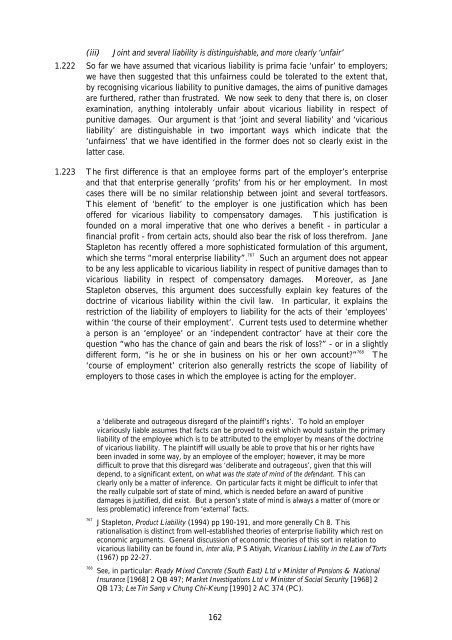Aggravated, Exemplary and Restitutionary ... - Law Commission
Aggravated, Exemplary and Restitutionary ... - Law Commission
Aggravated, Exemplary and Restitutionary ... - Law Commission
Create successful ePaper yourself
Turn your PDF publications into a flip-book with our unique Google optimized e-Paper software.
(iii) Joint <strong>and</strong> several liability is distinguishable, <strong>and</strong> more clearly ‘unfair’<br />
1.222 So far we have assumed that vicarious liability is prima facie ‘unfair’ to employers;<br />
we have then suggested that this unfairness could be tolerated to the extent that,<br />
by recognising vicarious liability to punitive damages, the aims of punitive damages<br />
are furthered, rather than frustrated. We now seek to deny that there is, on closer<br />
examination, anything intolerably unfair about vicarious liability in respect of<br />
punitive damages. Our argument is that ‘joint <strong>and</strong> several liability’ <strong>and</strong> ‘vicarious<br />
liability’ are distinguishable in two important ways which indicate that the<br />
‘unfairness’ that we have identified in the former does not so clearly exist in the<br />
latter case.<br />
1.223 The first difference is that an employee forms part of the employer’s enterprise<br />
<strong>and</strong> that that enterprise generally ‘profits’ from his or her employment. In most<br />
cases there will be no similar relationship between joint <strong>and</strong> several tortfeasors.<br />
This element of ‘benefit’ to the employer is one justification which has been<br />
offered for vicarious liability to compensatory damages. This justification is<br />
founded on a moral imperative that one who derives a benefit - in particular a<br />
financial profit - from certain acts, should also bear the risk of loss therefrom. Jane<br />
Stapleton has recently offered a more sophisticated formulation of this argument,<br />
which she terms “moral enterprise liability”. 767<br />
Such an argument does not appear<br />
to be any less applicable to vicarious liability in respect of punitive damages than to<br />
vicarious liability in respect of compensatory damages. Moreover, as Jane<br />
Stapleton observes, this argument does successfully explain key features of the<br />
doctrine of vicarious liability within the civil law. In particular, it explains the<br />
restriction of the liability of employers to liability for the acts of their ‘employees’<br />
within ‘the course of their employment’. Current tests used to determine whether<br />
a person is an ‘employee’ or an ‘independent contractor’ have at their core the<br />
question “who has the chance of gain <strong>and</strong> bears the risk of loss?” - or in a slightly<br />
different form, “is he or she in business on his or her own account?” 768<br />
The<br />
‘course of employment’ criterion also generally restricts the scope of liability of<br />
employers to those cases in which the employee is acting for the employer.<br />
a ‘deliberate <strong>and</strong> outrageous disregard of the plaintiff’s rights’. To hold an employer<br />
vicariously liable assumes that facts can be proved to exist which would sustain the primary<br />
liability of the employee which is to be attributed to the employer by means of the doctrine<br />
of vicarious liability. The plaintiff will usually be able to prove that his or her rights have<br />
been invaded in some way, by an employee of the employer; however, it may be more<br />
difficult to prove that this disregard was ‘deliberate <strong>and</strong> outrageous’, given that this will<br />
depend, to a significant extent, on what was the state of mind of the defendant. This can<br />
clearly only be a matter of inference. On particular facts it might be difficult to infer that<br />
the really culpable sort of state of mind, which is needed before an award of punitive<br />
damages is justified, did exist. But a person’s state of mind is always a matter of (more or<br />
less problematic) inference from ‘external’ facts.<br />
767 J Stapleton, Product Liability (1994) pp 190-191, <strong>and</strong> more generally Ch 8. This<br />
rationalisation is distinct from well-established theories of enterprise liability which rest on<br />
economic arguments. General discussion of economic theories of this sort in relation to<br />
vicarious liability can be found in, inter alia, P S Atiyah, Vicarious Liability in the <strong>Law</strong> of Torts<br />
(1967) pp 22-27.<br />
768 See, in particular: Ready Mixed Concrete (South East) Ltd v Minister of Pensions & National<br />
Insurance [1968] 2 QB 497; Market Investigations Ltd v Minister of Social Security [1968] 2<br />
QB 173; Lee Tin Sang v Chung Chi-Keung [1990] 2 AC 374 (PC).<br />
162
















